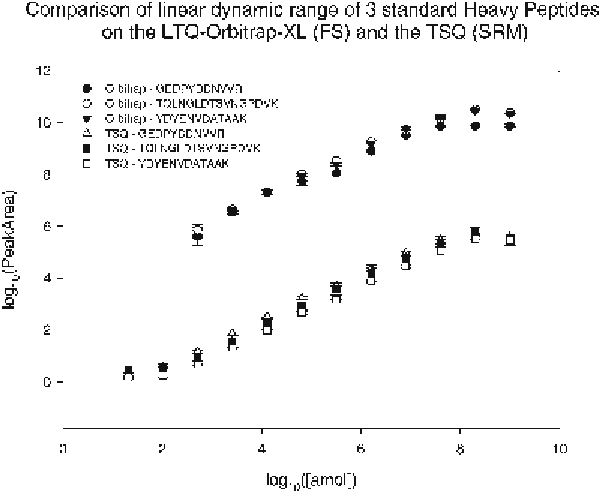Biology Reference
In-Depth Information
Fig.
3
Concentration versus Peak Area. Three Stable isotope labeled synthetic peptides was subjected to a
dilution series, and measured with the LTQ-Orbitrap-XL, in data-dependent acquisition mode, and the TSQ-
Vantage, in SRM-mode. Data indistinguishable from noise or simply not present are not depicted, and thus the
“missing” data points in the Orbitrap function at lower concentration levels. The linear and nonlinear parts of
the two functions are distinguished by the fl attening of the respective functions. In order to attain an optimal
coeffi cient of determination (
R
2
) similar for both instruments, the linear regression was calculated with a sub-
set of the data points. The resulting regression lines are depicted in the graph. The upper but especially the
lower limit of the TSQ regression line clearly extends to lower concentration levels, indicating heightened
sensitivity over a wider linear dynamic range
This is due to the fact that low concentration signals are detectable
in TSQ while the signal-to-noise ratio is already too low in the
LTQ-Orbitrap. Thus, when aiming to quantify very low abundant
targets in complex matrices, QqQs are the instruments of choice.
Recent developments in the fi eld of mass spectrometry include
optimized Ion Optics (enabling larger amounts of ions to be focused
in a shorter amount of time), data acquisition speed, data acquisi-
tion range, sensitivity [
10
-
13
] as well as the emergence of novel
DIA (Data Independent Acquisition) instruments, methods and
software [
14
]. Thus high resolution and high mass accuracy instru-
ments, such as the latest generation of the Orbitrap, are increasingly
competitive to QqQs. Additionally data produced by these instru-
ments is not restricted to quantifi cation as with SRM. These and
other studies show that at present the use of an LTQ-Orbitrap MS
may be an alternative to QqQ if the sensitivity is not limited [
10
].
For improved sensitivity of low abundant proteins using FullScan
high resolution high mass accuracy MS some instrument adjust-
ments may be useful (
see
Note 5
).

